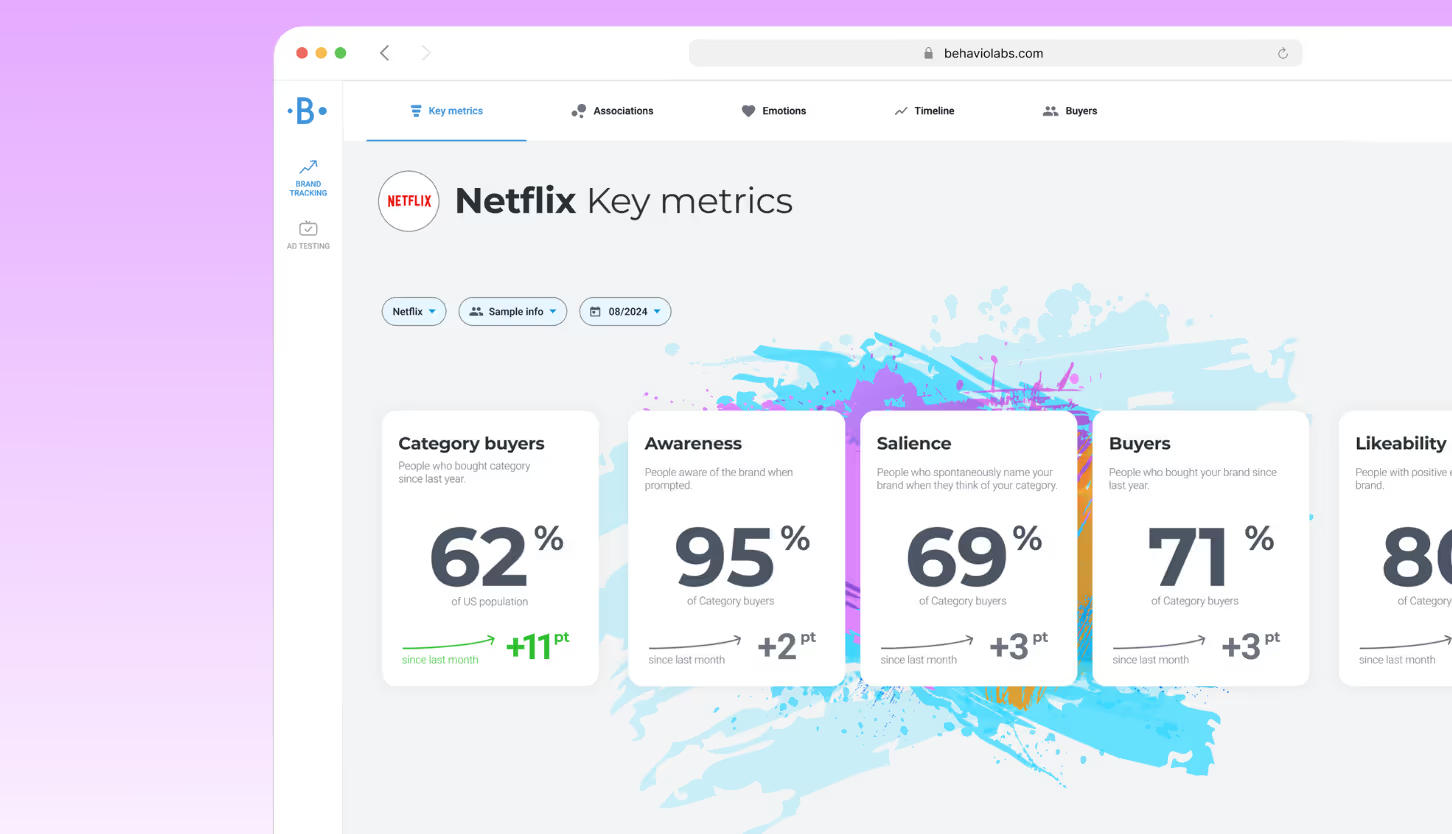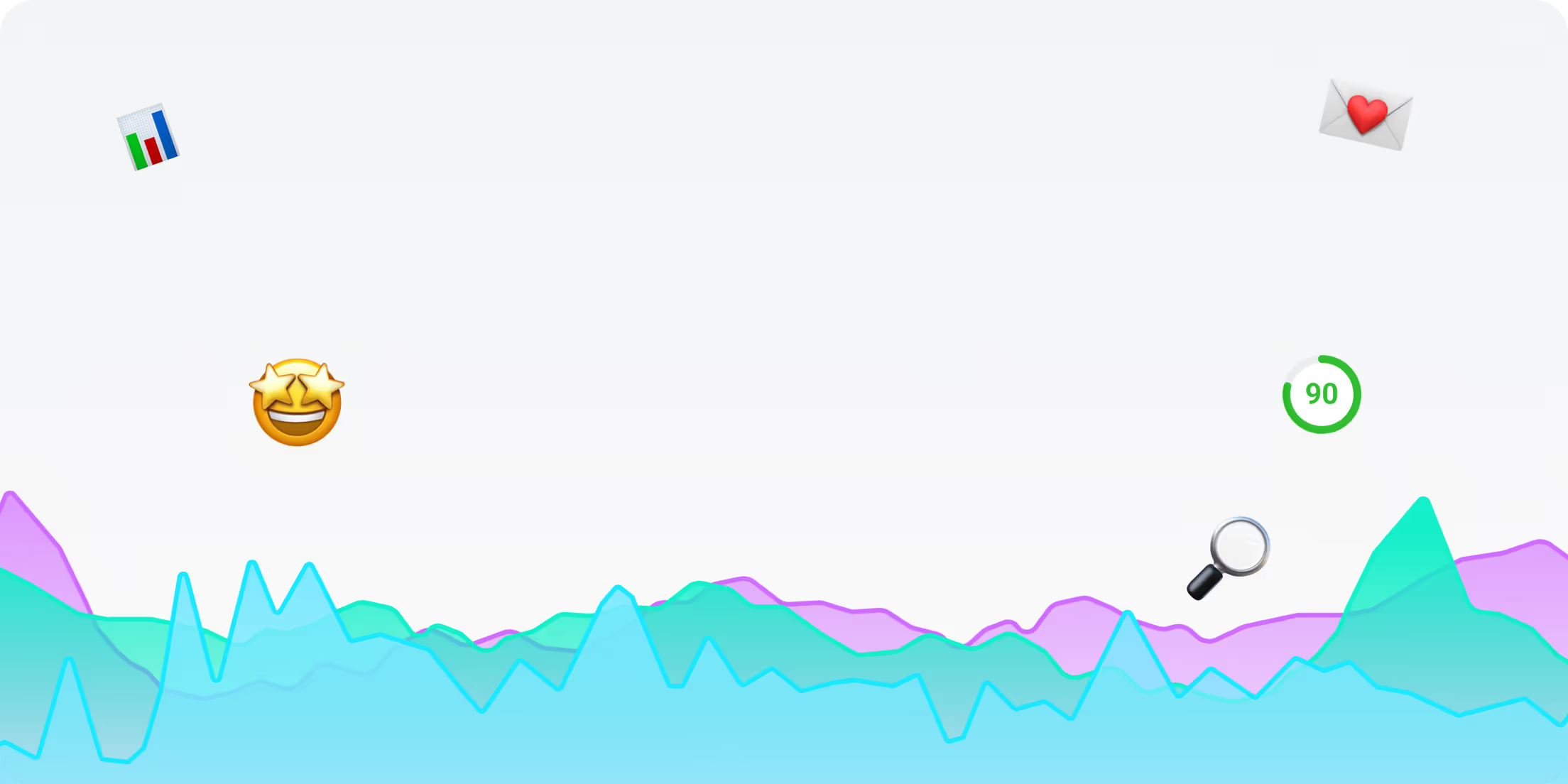We get it. The sheer amount of data and metrics you have to sift through on a day-to-day basis can be overwhelming.
However, understanding key performance indicators (KPIs) in your brand marketing is paramount for achieving visibility and growth.
Below is a comprehensive list of essential brand metrics and a short overview of which ones you should be tracking.
Sound good? Let’s get straight into it.
Types of brand metrics
There are four main types of brand health metrics that every marketer should understand and track regularly.
Brand awareness metrics
These metrics measure how well your target audience knows and recognizes your brand.
- Brand awareness: Percentage of consumers who recognize or recall your brand when prompted. Example: “Have you heard of [Brand X]?”
- Brand salience: How easily your brand spontaneously comes to mind in buying situations (“top of mind”). Example: When people think “soft drink,” do they say “Coca-Cola”?
- Share of search: The percentage of category-related searches mentioning your brand versus competitors.

2. Brand perception metrics
These measure how consumers feel about your brand and what associations they make with it.
- Brand associations: The traits, attributes, or situations people link to your brand (e.g., “fun,” “refreshing,” “eco-friendly”).
- Brand equity: The total value your brand adds to products through trust, reputation, and preference.
- Brand health: A holistic metric combining awareness, perception, and loyalty to show overall vitality.
3. Brand loyalty metrics
These metrics track how consistently consumers choose your brand over others and their long-term commitment.
- Brand loyalty: Repeat purchase behavior and emotional connection to your brand.
- Net promoter score (NPS): Measures how likely customers are to recommend your brand to others (Promoters – Detractors = NPS).
- Customer retention rate: The percentage of customers who continue buying your brand over time.
4. Brand Advocacy Metrics
These metrics indicate how strongly your audience supports and spreads positive word-of-mouth about your brand.
- Social mentions & sentiment: Track brand mentions, tone, and engagement on social media.
- Referral rate: How often existing customers bring in new ones.

Which brand metrics should you be tracking?
I know what you’re thinking: “That’s all great and all, but what’s really important?”
We’ve sifted through the clutter and researched the most important metrics to watch out for based on the size of your brand or business.
If you want a simple overview of the info below, check out our brand tracking cheatsheet.
What brand metrics track based on brand size:
Starting brands
- What counts as a starting brand: market penetration is less than 2%
- What you should try to achieve: convert customers who are actively looking for a solution (usually by targeting them with performance marketing).
- Metrics to monitor: category size
- Why should a starting brand track category size: tracking category size helps a starting brand understand the overall market potential and identify opportunities for growth.
By knowing the size of the category, the brand can assess its market share and set realistic targets for expansion.
Small brands
- What counts as a small brand: market penetration is between 2% and 10%
- What you should try to achieve: raise awareness about your brand or product.
- Metrics to monitor: brand awareness, brand emotion
- Why should a small brand track brand awareness: brand awareness is crucial for a small brand as it determines the level of recognition and familiarity among consumers.
By tracking brand awareness, a small brand can measure the effectiveness of its marketing campaigns and initiatives in reaching its target audience. - Why should a small brand track brand emotion: tracking brand emotion enables a small brand to understand the emotional connection consumers have with its brand or product. Emotions play a significant role in consumer decision-making and influencing brand preference.
Medium brands
- What counts as a medium brand: market penetration is between 10% and 30%
- What you should try to achieve: be a salient brand in the selected category entry point (CEP).
- Metrics to monitor: brand salience, brand associations
- Why should a medium-sized brand track brand salience: brand salience reflects the brand’s prominence and top-of-mind awareness among consumers within its chosen category entry point (CEP).
For a medium-sized brand, being salient in the CEP is crucial for maintaining competitive advantage and driving consideration and purchase intent. - Why should a medium-sized brand track brand associations: brand associations represent the attributes, values, and characteristics linked to the brand in the minds of consumers.
For a medium-sized brand, tracking brand associations is essential for shaping brand identity and differentiation.
Large brands
- What counts as a large brand: market penetration is above 30%
- What you should try to achieve: be a salient brand in the strongest category entry points (CEP) of the entire category.
- Metrics to monitor: mental market share (salience across multiple category entry points), brand associations
- Why should a large brand track mental market share/brand salience: by monitoring mental market share, the brand can assess its position relative to competitors and identify opportunities to strengthen its presence in strategic CEPs.
It enables the brand to allocate resources effectively, prioritize marketing initiatives, and adapt its strategies to reinforce salience where it matters most. - Why should a large brand track brand associations: for a large brand, monitoring brand associations allows for identifying strengths to leverage and weaknesses to address.
It enables the brand to align its messaging and experiences with its desired positioning, fostering deeper connections and resonance with consumers.
What does Behavio measure and how?
At Behavio, we focus on the brand metrics that matter most:
- Brand awareness
- Brand salience
- Brand emotion
- Brand associations

Our brand tracking platform uses behavioral data to reveal how your audience actually perceives your brand — not just what they claim in surveys.
Why brands choose Behavio
- Actionable dashboards: Clear, visual data (no jargon-filled reports).
- Quick onboarding: Get started in 30 minutes — no complex setup.
- Affordable insights: Access advanced brand health metrics for a fraction of traditional research costs.
With Behavio, you’ll know exactly where your brand stands and how to improve it.
Frequently asked questions
It depends on your brand’s stage. Awareness and salience are critical early on; emotion, loyalty, and advocacy matter most once your brand matures.
Ideally, every quarter. This helps you spot trends and measure the long-term impact of brand campaigns.
Brand health metrics track perception and equity, while performance metrics focus on sales and conversions. Both are essential for full-funnel marketing insight.











.avif)








